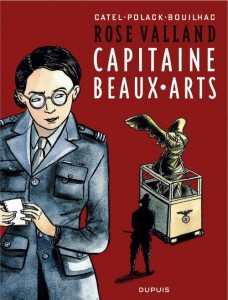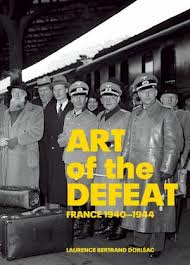 This week in the war, on 24 September 1940, Mademoiselle Rose Valland received a grant of 10,000 francs to conduct research into art. Her adventures are described in Rose Valland: Capitaine Beaux Arts (Dupuis, 2009), a captivating book by Catel, Polack and Bouilhac which is part bande dessinée (comic strip) and part text, and liberally sprinkled with photographs of Mlle Valland during the war years.
This week in the war, on 24 September 1940, Mademoiselle Rose Valland received a grant of 10,000 francs to conduct research into art. Her adventures are described in Rose Valland: Capitaine Beaux Arts (Dupuis, 2009), a captivating book by Catel, Polack and Bouilhac which is part bande dessinée (comic strip) and part text, and liberally sprinkled with photographs of Mlle Valland during the war years.
Much of the book centres on the Jeu de Paume, the Paris art museum (and former tennis court of Napoleon III) where Nazi leader Alfred Rosenberg set up the Einsatzstab Reichsleiter Rosenberg (ERR) for the purpose of processing confiscated works of art. For confiscated, read looted. For processing, read selling off to the highest bidder or sending off to Hitler for the museum he was planning in Linz.
On the 5th of November, Luftwaffe Chief Hermann Goering—whose forces had fared badly in the Battle of Britain—showed up at the Jeu de Paume to select some choice pieces for Carinhall, his palace on the outskirts of Berlin. The cover of the Rose Valland book shows a German officer inspecting the famous Winged Victory of Samothrace (La Victoire de Samothrace). Maybe this is meant to be a plaster copy? Four such copies were made, and one was eventually retrieved from Carinhall at the end of the war. The original (circa 200 BC) Victory statue was crated before the fall of France and sent for safekeeping to the Chateau de Valençay.
 As a member of the Jeu de Paume’s curatorial staff, Rose Valland kept detailed records of the contents of the crates of painting, which arrived by the hundreds, and she took careful note of their ultimate destinations. She did this secretly at night, and at great peril to herself. Part of her story can be found in the book by Laurence Bertrand Dorléac, Art of the Defeat: France 1940–1944 (J. Paul Getty Trust, 2008).
As a member of the Jeu de Paume’s curatorial staff, Rose Valland kept detailed records of the contents of the crates of painting, which arrived by the hundreds, and she took careful note of their ultimate destinations. She did this secretly at night, and at great peril to herself. Part of her story can be found in the book by Laurence Bertrand Dorléac, Art of the Defeat: France 1940–1944 (J. Paul Getty Trust, 2008).
At war’s end, she was awarded the médaille de la Résistance Française and became a chevalier de la Légion d’honneur.
